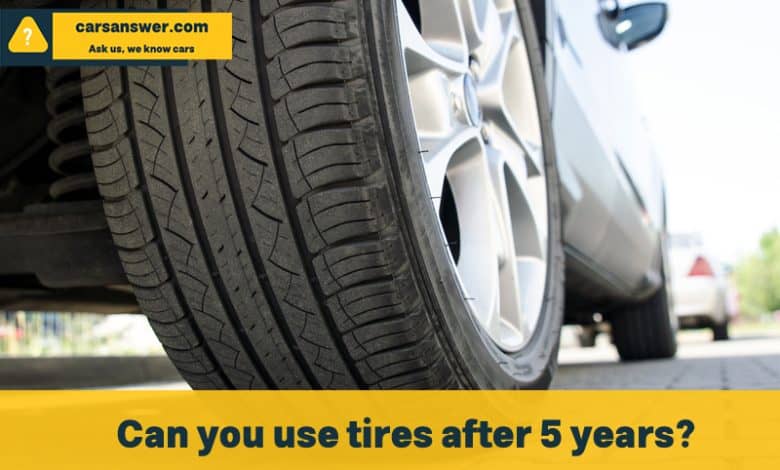Can you use tires after 5 years?

Tires are a crucial component of a vehicle’s performance, and their proper maintenance and replacement is essential for safety on the road. Tires can last for several years, but many people wonder if it is safe to use them after 5 years. In this article, we will explore the lifespan of tires and the factors that can affect their safety and performance, and provide detailed information about how to check the age of a tire and when to replace them.
How long do tires last?
The lifespan of a tire depends on several factors such as their construction, usage, and maintenance. According to the National Highway Traffic Safety Administration (NHTSA), tires should be replaced every six years, regardless of their condition or mileage. However, this is just a general guideline, and the actual lifespan of tires can vary widely depending on the factors mentioned earlier.
Tire construction plays a significant role in the lifespan of a tire. Tires with softer rubber compounds will wear out more quickly than those with a harder compound. Additionally, tires with a higher load capacity or speed rating may wear out more quickly than those with a lower capacity or rating. The construction of the tire can also affect its resistance to punctures and cuts, which can significantly impact its lifespan.
The usage of a tire is also a significant factor in its lifespan. Tires that are driven on frequently and for long distances will wear out more quickly than those that are driven less often and for shorter distances. Driving on rough or uneven roads can also affect the lifespan of a tire, as it puts additional stress on the tire and can cause it to wear out more quickly.
Proper maintenance is also essential for the longevity of a tire. Tires that are properly inflated, rotated, balanced, and aligned will last longer than those that are not. Overinflated or underinflated tires can cause uneven wear and reduce the lifespan of the tire. Additionally, tires that are not rotated regularly can wear out more quickly on one side of the vehicle than the other. Proper alignment and balancing of the tires can also prevent uneven wear and extend their lifespan.

Signs that tires need to be replaced
Even if a tire is less than 5 years old, there are several signs that may indicate that it needs to be replaced. These signs include low tread depth, cracks or bulges, vibrations, and punctures or cuts.
Low tread depth is a common sign that tires need to be replaced. The tread on a tire provides traction and stability on the road, and as it wears down, the tire becomes more susceptible to hydroplaning on wet roads and losing traction on slippery surfaces. The NHTSA recommends that tires be replaced when the tread depth reaches 2/32 of an inch. A simple way to check the tread depth of a tire is to insert a penny into the tread with Lincoln’s head facing down. If you can see the top of Lincoln’s head, the tread is worn down to 2/32 of an inch and the tire needs to be replaced.
Cracks or bulges in the sidewall or tread of a tire can indicate that it is aging and needs to be replaced. These cracks and bulges can occur due to exposure to sunlight, extreme temperatures, or other environmental factors. They can also indicate that the tire is developing a leak or structural damage that can cause a blowout.
Vibrations while driving can be a sign that the tires are worn out or out of balance. This can cause a rough ride and can also indicate that the tires are no longer providing adequate traction and stability on the road.
Punctures or cuts in the tire can compromise its structural integrity and increase the risk of a blowout. Even small punctures or cuts can weaken the tire and cause it to lose air pressure or fail while driving.

Can you use tires after 5 years?
While tires can technically be used after 5 years, it is not recommended. The NHTSA recommends that tires be replaced every six years, regardless of their condition or mileage. This is because the rubber in tires can deteriorate over time, even if the tires are not used frequently. The deterioration of the rubber can cause the tire to become brittle and more susceptible to punctures, cuts, and blowouts.
There are several factors that can affect the rate of deterioration of a tire, such as the climate in which it is stored and the frequency of use. Tires that are stored in a cool, dry place away from sunlight and extreme temperatures may last longer than those that are exposed to these environmental factors. Tires that are used frequently and driven on rough or uneven roads may wear out more quickly than those that are used less often and on smooth surfaces.
It is important to note that the age of a tire is not the only factor that determines its safety and performance. The condition of the tire, such as the tread depth and the presence of cracks or bulges, is also essential in determining whether or not it is safe to use.
How to check the age of a tire
The age of a tire can be determined by looking at the DOT number on the sidewall of the tire. The DOT number is a four-digit code that indicates the week and year that the tire was manufactured. For example, if the DOT number is 2319, it means that the tire was manufactured in the 23rd week of 2019.
It is important to note that the DOT number does not indicate the age of the tire from the date of purchase. If a tire was manufactured several years ago but has not been used or exposed to environmental factors, it may still be safe to use.
Conclusion
Proper tire maintenance and replacement is essential for vehicle safety and should not be neglected. While tires can technically be used after 5 years, it is not recommended due to the deterioration of the rubber over time. Signs that a tire needs to be replaced include low tread depth, cracks or bulges, vibrations, and punctures or cuts. The NHTSA recommends that tires be replaced every six years, regardless of their condition or mileage. It is important to check the age of your tires and replace them as needed to ensure safe and reliable driving. Proper tire maintenance, including proper inflation, rotation, balancing, and alignment, can also extend the lifespan of a tire and improve its safety and performance on the road.





